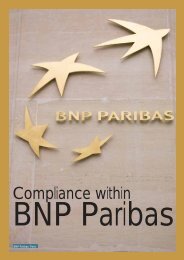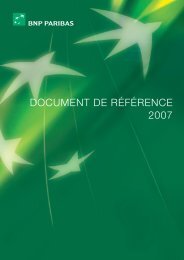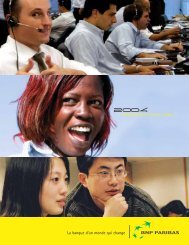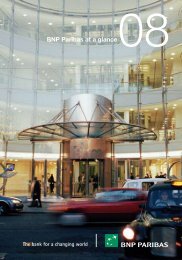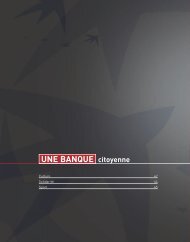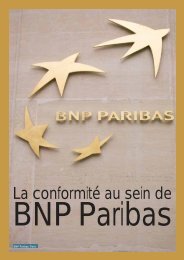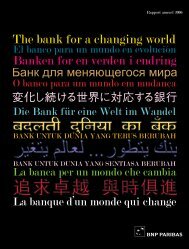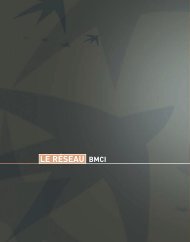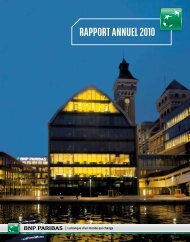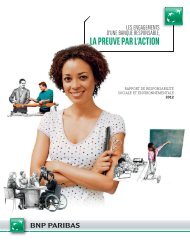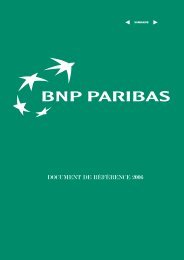La banque d'un monde qui change 2004 - BNP Paribas
La banque d'un monde qui change 2004 - BNP Paribas
La banque d'un monde qui change 2004 - BNP Paribas
Create successful ePaper yourself
Turn your PDF publications into a flip-book with our unique Google optimized e-Paper software.
on retirement bonuses should be accounted for as a planamendment. Consequently, the provision recorded in prior yearshas been written off against e<strong>qui</strong>ty at 1 January <strong>2004</strong> and thepast service cost is being recognised in profit or loss over theestimated remaining working lives of the employees concerned.A provision has been recorded in the opening IFRS balancesheet, with a corresponding adjustment to e<strong>qui</strong>ty, to coverthe Group’s obligations towards retired employees who receivesupplementary healthcare benefits under the <strong>BNP</strong> <strong>Paribas</strong>mutual insurance plan. In <strong>2004</strong>, the Group’s obligations wereextinguished through a lump-sum payment of an amount thatwill cover all future healthcare costs of retired employees,considering forecast trends in healthcare costs and increasesin contributions payable by plan participants.• Share-based payments (IFRS 2):The cost of stock options granted to certain employees isrecognised in the profit and loss account over the option vestingperiod, with a corresponding increase in e<strong>qui</strong>ty. This accountingtreatment has no effect on e<strong>qui</strong>ty. Share-based deferredcompensation expenses are charged to the profit and loss accountover their vesting periods and the shares purchased for allocationto the beneficiaries are deducted from e<strong>qui</strong>ty.• Property and e<strong>qui</strong>pment (IAS 16 and 36) and investmentproperty (IAS 16 and 40):The Group has elected to measure operating assets accordingto the cost model and the effects of the revaluationsperformed in 1991, 1992 and 1995 have therefore beencancelled, leading to a corresponding adjustment of e<strong>qui</strong>ty.Investment properties held to earn rentals and for capitalappreciation are also measured according to the costmodel, except for those properties held by Group insurancecompanies in unit-linked portfolios which are measured usingthe fair value model in accordance with IAS 40.In the IFRS financial statements, properties measuredaccording to the cost model are depreciated by thecomponents method, which consists of depreciating individualcomponents of assets separately over their respective usefullives. The resulting adjustments to accumulated depreciationat 1 January <strong>2004</strong> have been recognised in e<strong>qui</strong>ty. The <strong>change</strong>of method also affects annual depreciation expense.Software (IAS 36 and 38)Software has been analysed by category, with eachcategory amortised over a different useful life. The resultingadjustments to accumulated amortisation at 1 January <strong>2004</strong>have been recognised in e<strong>qui</strong>ty. The <strong>change</strong> of method alsoaffects annual amortisation expense.Goodwill (IAS 36 and IFRS 3)For the purpose of applying IAS 36 and IFRS 3, the Group’sbusinesses have been analysed by cash-generating unit.Goodwill allocated to each cash-generating unit is notamortised, but is tested for impairment using the methodsprescribed in these standards.• Leases (IAS 17):According to IAS 17, contracts sold by the vehicle leasingsubsidiaries represent operating leases and the correspondingassets have therefore been reclassified under property ande<strong>qui</strong>pment. The vehicles are depreciated on a straight-linebasis rather than using the interest method. Depreciationschedules have been adjusted to take into account <strong>change</strong>s inresidual values, and initial direct costs incurred in negotiatingand arranging the operating leases are added to the carryingamount of the leased vehicles. The effects of these <strong>change</strong>sof method have been recognised in e<strong>qui</strong>ty in the opening IFRSbalance sheet at 1 January <strong>2004</strong>. The <strong>change</strong>s of method alsoaffect annual depreciation expense.• Scope of consolidation (IAS 27, 28, 31 and SIC 12):Under IAS 28, investments in associates must be accountedfor by the e<strong>qui</strong>ty method even if they are being held for sale.Consequently, investments held in the private e<strong>qui</strong>ty portfoliothat fulfil the relevant criteria have been included in the IFRSscope of consolidation, mainly by the e<strong>qui</strong>ty method.In addition, certain special purpose entities, set up mainlyin connection with securitisation programmes, have beenconsolidated in accordance with interpretation SIC 12.<strong>La</strong>stly, the accounts of associates already accounted forby the e<strong>qui</strong>ty method in the French GAAP accounts havebeen restated in accordance with IAS/IFRS. The effect ofthe resulting <strong>change</strong>s of method has been recognised in e<strong>qui</strong>tyin the opening IFRS balance sheet at 1 January <strong>2004</strong>.Standards applicable as of 1 January 2005The Group applies European Commission regulation (EC)no. 2086/<strong>2004</strong> dated 19 November <strong>2004</strong> endorsing IAS39 minus the provisions on the fair value option and certainprovisions relating to portfolio hedging.• Allowances for impairment losses on loans (IAS 39):Adoption of IAS 39 does not lead to any <strong>change</strong> in the criteriaapplied by the Group to identify impaired loans. However, therelated provisions must take into account expected futurecash flows from the loans, discounted at the loans’ originaleffective interest rate. The resulting increase in provisions176<strong>BNP</strong> PARIBAS - ANNUAL REPORT <strong>2004</strong>



